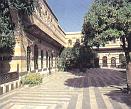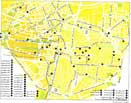| |
Introduction 
Damascus city (Dimashq), the capital of Syria, is the oldest continuously inhabited city in the world. While all the world is now entering the third millennium, Damascus is entering its sixth. Once the capital of the Umayyad Dynasty, it now houses the Syrian Government and with a population of 3.5 million, is the hub of Syrian economic affairs.
Geographically, Damascus is situated in the south-western corner of Syria. It is built at the foot of a buttress of the Anti-Lebanon, Mount Kassioun, and at the border of a fertile plain, the Ghouta. It is situated just a two-hour drive away from the Lebanese capital Beirut and the Jordanian border, and about the same from the temporary Israeli border at the Golan Heights. The villages of Maaloula and Seidnaya are less than an hour away, and so is the Mosque of Al Sayidah Zeinab.
There is a direct route from Damascus to the ancient city of Palmyra, and a direct route running all the way to Homs and Aleppo, via Homs and Hama. There is also a direct route leading to the Jordanian border, and another through which you can visit Qanawat, Shahba, Bosra and other Southern sites.
History
The first mention of Damascus is in Egyptian records of four thousand years ago,as a city conquered in the 15th century BC by the Pharaoh Thutmosis III. According to the Old Testament, it was once the capital of the Aramean Kingdom in the 11th Century BC. In the 10th Century BC, it started being attacked and it was in battle with several other kingdoms including the Hebrews and Assyrians.
After 1200 BC the kingdom of Damascus became a powerful state that long defied Assyria. Finally, in 732 BC, it was taken over by Tiglath Pileser II ordered by the King of Judea, Achaz. Some years after the fall of the Assyrian capital, Nineveh, the Kingdom of Damascus was destroyed by Babylon. Damascus was conquered in 333 BC by Parmenion, one of Alexander's lieutenants, who took it from the Persians. It later fell to the Seleucids who fell into dispute with a branch of the empire of the Macedonian conqueror, the Lagides, who ruled Egypt. In 66 BC it was occupied by Pompey and belonged to the province of Syria.
At the beginning of this era, St. Paul was sent to put down the Christians, he had the revelation of faith. He was directed by Jesus (in the vision of light) to the house of Judas. There he met Ananias and together they preached for Christ.
Under the Byzantine Empire, Damascus was an important base for watching over the Syrian Desert, But it was fatally looted by the Sassanid Persians. Damascus was later besieged by the Muslim faith fighters in 635 AD, and was retaken by Khaled Ibn al Waleed in 636. This meant a radical change of civilization for this city as it swung from Byzantium and Christianity to the Orient and the Semitic world. This marked the beginning of the city's golden age which reached its apex in 661, when it became the capital of the Great Arab Empire that stretched from Spain to India, under the Umayyad Dynasty.
Damascus was the most important centre of Arab Islamic culture before it lost most of its importance to Baghdad in 750. This golden age ended with the Abbasids who moved the Capital to Baghdad. From then on, it fell under the power of various Muslim sects and sovereigns, the most important of which was the Egyptian Fatimids. It later went through another rich period, when Saladin took it from the Fatimids and started the Ayyubid Dynasty. At the time it was battling against the Franks (the Crusaders). Numerous monuments built by Nur al Din and Saladin are still the pride of Damascus.
In 1260 it was taken over by the Mamelukes of Egypt who pushed the Mongols back. The city was captured by the Ottoman Sultan Salim I in 1516 and the Ottoman occupation lasted for the next four centuries, until World War I.
After World War I, a very exhausted Damascus was liberated in 1918, by an Arab contingent under the command of the British Army of General Allenby. The Syrian National Congress was formed in 1919 under the patronage of Emir Faisal who came from Hedjaz. He was named King of Syria in 1920, but British and France had their own different plans, and one month later was taken over by the French in the name of the League of Nations. However, the Syrian people decided to resist.
In 1925, the Great Syrian Revolution against the French was launched from Jabal-al-Arab. Many battles between the revolts and the French troops took place in the farms of al-Ghouta outside Damascus. The city was bombed by the French and parts of it were severely damaged. Again in 1945, the French carried out a similar aggression against the Syrian Parliament buildings in Damascus.
After resistance and a few uprisings, Syria was proclaimed Independent by the French general, Catroux, on September 16th 1941. This however was not taken into effect until 1946 and since then has been considerably developed and industrialized while its political role was strengthened thanks to an increased centralization.
The Syrian capital had witnessed great changes during the past 50 years. Much modernization had occurred. The city's area and population count doubled many times. Today an estimated population of 3 million lives in Damascus.
Attractions and historical building
Now, Damascus is a wonderful mixture of old and new. In the modern part of the city there are up-to-date homes, hotels and government buildings. Whereas in the Old City, you can watch the graceful minarets and domes of more than 200 mosques rise above the famous one-story Damascene houses.
Damascus is famous for its bazaars. Bazaars are streets lined with shops, stalls and cafes. One of these is the Called "Street Straigh", mentioned in the Bible in connection with St. Paul's conversion to Christianity. The tomb of John the Baptist (Prophet Yahia in the Quran) is situated in the Grand Umayyad Mosque in the centre of the old city.
The Umayyad Mosque is the symbol of Damascus. Built by Caliphate Al-Walid I in the 7th century, this mosque is a wonderful example for Islamic art and architecture. Other historic monuments in Damascus include the Azem Palace, a typical Damascene house of the 18th century.
|
|







